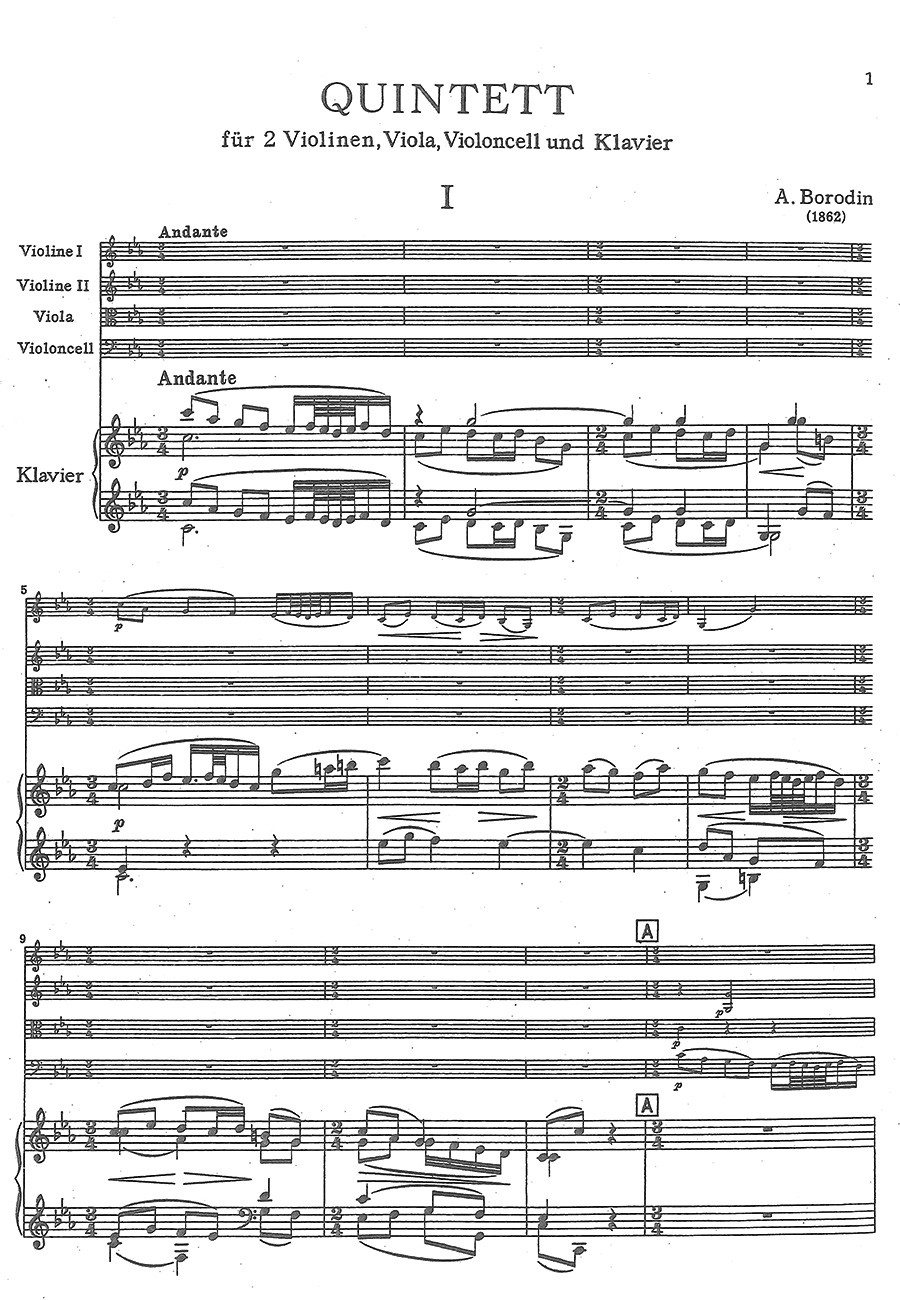Piano Quintet in C minor (Full Score)
Borodin, Alexander
20,00 €
Preface
Alexander Borodin – Piano Quintet in C minor
(b. St. Petersburg, 31 October [12 November] 1833 — d. St. Petersburg, 25 [27] February 1887)
The music of Alexander Borodin enjoys a worthy reputation for its high technical and structural com-petence, and for its often unexpected haunting melo-diousness. The C minor piano quintet, dating from 1862, a year spent for the most part in Italy with his recuperating fiancée, is frequently hailed as the masterpiece of this early compositional period. Yet, for all the genuine attractiveness of its musical surface and the folklike delicacy of its thematic content, the piece is not completely easy to apprehend. The reason appears to be its curious, though noble, amalgamation of different elements: a sophisticated practical construction of musical form born from a love of playing and appreciation of music, juxtapositions of appealingly evocative passages with more conventional material, and the use of apparently idiosyncratic tonal schemes. Borodin’s academic training in chemistry seems to have contributed greatly to the mental sophistication of his music, though he lacked formal academic training in music. Borodin’s use of standard musical forms – again, described by many commentators as innovative – frequently draws him into looser, even more daring tonal structures, and this is a strong feature of the quintet and may in fact give it a sense of unease, which, in order to be reconciled with the type of “academic” music to which the Western musical world is accustomed, may demand that we give the work a slightly different kind of listening or reading than we would, for example, a chamber piece by Borodin’s contemporary Brahms. In other words, we must probably begin to understand Borodin’s fluidity of compositional approach as needing less formal and structural justification in comparison to its Western European peers that were constructed according to more rigorously applied canons. This is not least due to the subtlety Borodin displays as he generates a cascading one-piece flow of music that through its highly appealing material abates the quite obvious seams in its structure and voids any impression of amateurism.
Serge Dianin, Borodin’s Soviet biographer, provides a linear account of the quintet that contextualises the folk influences Borodin absorbed for its composition. Dianin relates the piece to earlier music by Chopin, Schumann, Mendelssohn and their Russian contemporary Glinka. Borodin had heard the Schumann piano quintet in 1861 and emulated Schumann’s piano writing and discreet string interplay, imbuing with his particular brand of folk melody. Dianin discerns a rondo structure in the first movement, Andante. It is organised around two lyrical but contrasting themes. The piano assumes pre-eminence in this movement and throughout the quintet, and it is suitable for stating both themes. The first theme begins in C minor, with a slight ambiguity in the melodic structure since the first four notes outline the key of F minor and the rest of the short phrase resolves a little uncertainly on C minor. The rest of the melody wanders modally, the decisive leading note not occurring until the final beat of bar 4, by which point the metre has restlessly changed from triple to duple time. This four-bar statement is contrapuntally elaborated until bar 23, by which time the music has settled conventionally on the relative major. Then the cantabile second theme enters, with Schumannesque piano writing. Again, this is elaborated, until the music dies away atmospherically from bar 37 onwards. At bar 44 the first theme recurs, in the relative major, before it is shifted to the subdominant minor (F minor, bar 48).
So, by bar 44, Borodin has clearly set up a perhaps somewhat crude process of stating material plainly (or plaintively, given the plangency of the folk elements) and then simply elaborating it. It is the motional impulse by which he does this that prevents the music from being square and static. Borodin’s technique of musical segmentation in this movement is founded on the clever interruption of musical phrases by restating them with greater force or higher dynamics (and possibly register as well), increasing the tension. This is nowhere more apparent than at bar 56 in the epic pianistic reprise of the first theme, which is simply a heightened version of it intervening in the texture in place of any thematic development. Unlike any other moment in the quintet is the cello arietta that immediately follows this passage (in bars 67 to 70), with its brightening but somewhat eerie tonal shift from A flat major to C major, naturalising the a, lowering the dynamic abruptly and impalpably changing the metre (in by now characteristic fashion).
Read full preface > HERE
Score Data
| Edition | Repertoire Explorer |
|---|---|
| Genre | Chamber Music |
| Pages | 60 |
| Size | 210 x 297 mm |
| Performance materials | available |
| Printing | Reprint |
| Size | 210 x 297 mm |
